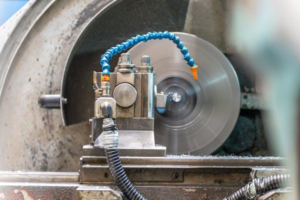
Compliance and safety hold huge importance when it comes to the operation of any equipment in the manufacturing industry. Strict adherence to safety standards is crucial for preventing accidents and promoting a secure work environment. Non-compliance can lead to severe risks like injuries and equipment damage. It is important that people operating and maintaining these machines understand the significance of following safety protocols. So, in this post, we will look at how to ensure compliance with safety standards when operating hose cutting machines.
Inspecting Hose Cutting Machines
- Check for blade guards: Operators should ensure that the blade guards of the hose cutting machine are in place before using the tool. Blade guards are used to prevent accidental contact with the cutting blade, thus reducing the risk of severe injuries and enhancing safety during operation.
- Inspecting for leaks: In the case of hydraulic hose-cutting machines, it is crucial to check the machine for any leaks since high-pressure hydraulic fluid can cause serious harm if it escapes from the system.
How to Prepare the Work Area?
- A clean and organised workspace will minimise the risk of accidents. Hence, operators should make sure that they remove any debris obstacles that may interfere with the operation of the hose-cutting machine. An orderly environment will ensure smooth workflow and reduce the likelihood of slipping hazards.
- Verify proper lighting and ventilation: Proper lighting and ventilation ensure safe machine operation. Adequate lighting will allow the operators to see clearly, thus reducing the chances of errors. Good ventilation will ensure that any fumes or dust generated during the cutting process does not accumulate, thus maintaining a healthy work environment.
Proper Operation of the Hose Cutting Machine
Choosing the right blade
- Types of blades: Operators to select the right blade type for each hose. Different hoses require specific blades to ensure clean cuts and prevent damage.
- Ensure that the blade is undamaged and sharp: A sharp and undamaged blade is essential for the safe operation of the hose-cutting machine. Damaged blades can lead to improper cuts and increase the risk of accidents. So make sure that you regularly inspect the blade for wear and tear and replace any blades that show signs of damage.
Operating the hose-cutting machine
- Correct position of the hose: Make sure that the hose is placed securely in the machine’s cutting area and that it lies flat and straight to avoid uneven cuts. Improper positioning of the hose can lead to damage and accidents.
- Avoid forcing the hose into the blade: Never force the hose into the blade as it can cause the hose to clip off the blade to break, thus leading to serious injuries. Apply steady and even pressure to guide the hose through the blade to ensure a clean cut and reduce the risk of accidents.
To Sum Up
This highlights the essential safety measures for operating a hose-cutting machine. Apart from pre-operation inspections and proper operation techniques, regular and ongoing maintenance is crucial to ensure a safe work environment. Hence, operators should make sure that they stay updated with industry standards and regulations. Proper compliance with safety measures will ensure that the equipment, as well as the operating personnel, are safe.
Featured Image Source: https://images.pexels.com/photos/28752150/pexels-photo-28752150/free-photo-of-industrial-lathe-machine-in-action.jpeg?auto=compress&cs=tinysrgb&w=600


Leave a Reply